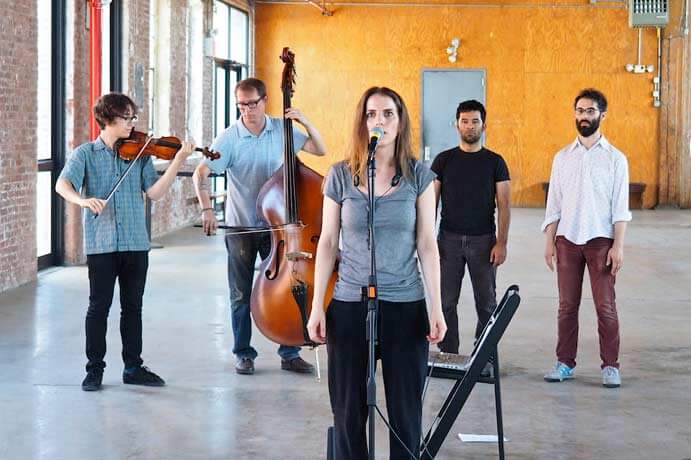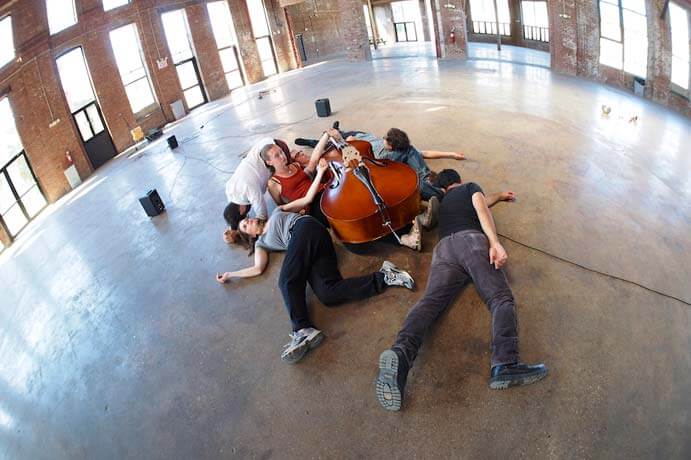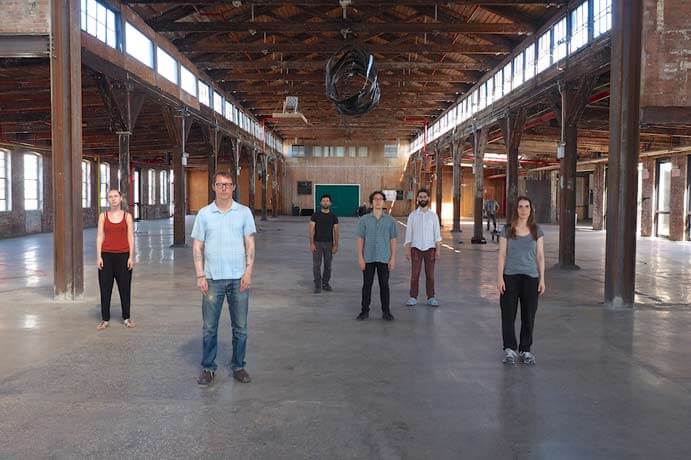Three years of work will unfold when the artist collective thingNY premieres their new opera This Takes Place Close By at the Knockdown Center in Queens, New York, on Thursday, September 24, 2015. The work, inspired by traumatic events like hurricanes Katrina and Sandy, explores the fractured world that emerges in the wake of a devastating storm. We spoke with thingNY members Erin Rogers, Andrew Livingston, and Jeffrey Young, and stage director Ashley Tata to find out more.
What is thingNY’s process for making collaborative opera?
Erin Rogers: We six members have been collaboratively composing since 2008. We meet at least once a week. We eat, tell stories, digress, watch funny YouTube videos, then attempt to focus. Members bring different ideas – musical, theatrical, scored, unscored, formed, unformed, a structured improv, an unstructured set of rules, a list of ramblings, a shark tooth. The process is organic. We perform everything – vocally, instrumentally, silently. The vibe is game-like, playful but with something larger at stake. There is trust. There is reliance on each other’s skill, enthusiasm, and instinct to make things work. At first, ownership varies, usually based on who conceived the idea, but all ideas are raw and malleable, all opinions are heard, and all sides are explored. The vetting can be harsh. The decision to keep or cut is not democratic. Composing together takes longer than if we composed alone, but the result is greater.
How did natural disasters like Katrina and Sandy lead to development of This Takes Place Close By?
Andrew Livingston: We were kicking around ideas for a big piece and the idea of weather really captivated all of us. The more we mulled over it, the more it became clear we were all interested in storms and their aftermath. It seemed very relatable both literally and metaphorically to us. We workshopped the piece extensively and performed many versions of it with varying degrees of staging. Over time, the story has boiled down to being a character study of sorts, in which each character represents different ways of being victimized by, and/or coping with, a storm. The audience will move through moments of the different characters’ situations, which is more interesting to us than a traditional narrative. We have all edited and shaped each others’ texts and musical ideas throughout the compositional process such that everyone has moments in which their compositional style is heard and the strengths of the group as a whole are utilized as well.

thingNY members (l-r) Jeffrey Young, Andrew Livingston, Erin Rogers, Paul Pinto, and Dave Ruder (photo by Michael Yu)
What makes the Knockdown Center an ideal space for this performance?
Ashley Tata: If the performance were in a traditional theater, we would likely attempt a set that looks like the Knockdown Center. Here, we can create more abstract elements that exist within a literal-feeling setting. The set designer—visual artist Jesse Greenberg—is creating a series of sculptures that function as location and framing devices to suggest a physical and visual perspective to the audience. The lighting and projection designs further direct the audience’s gaze and movement, as they play the textures and architecture of the space. Focus alternates from micro to macro. The piece is characterized by voices calling out into the universe without response. Housing the piece at Knockdown emphasizes that disconnection and allows for its extreme opposite: the fullness of an ensemble listening and playing together across vast expanses.
How have the acoustic features of the Knockdown Center influenced the composition of the piece?
Jeffrey Young: We’ve developed this piece for the better part of three years in apartments, small theaters, churches, and cultural centers. But once we settled on Knockdown Center for the premiere, we knew we wanted to take the space’s remarkable size and long reverb into account. So in our revisions leading up to the premiere, we consigned the use of tight harmonies and rhythms mostly to parts of the piece where we could be physically close to each other, using the space’s natural reverb to enhance the music rather than prevent us from playing together accurately. We also used the distance between musicians as a musical variable. There’s one point in the piece where I speak and accompany myself on violin in one room, while in the next room, the rest of the group vocalizes and knocks on parts of the building’s architecture while walking away. The effect is one of dislocation, emphasizing the insensitivity of my character to the chaos around him.

thingNY in rehearsal at the Knockdown Center (photo: Michael Yu)
So, what will the finished piece be like as a work of theater?
Ashley Tata: I think of This Takes Place Close By as an installation activated by performance. Ideally, audience members will arrive at the space, which—as a destination for some—provides distance between where they were and where they will be. This allows them to give over to the space and enables immersion into the sonic world that is created by these composers and their performances. As one moves from location to location within the space, the mind can wander. It can take in information and sonic cues, but doesn’t need to assemble these in a dictated way. Thoughts about our world, the enormity of it, the interconnectedness of it, the fragility of it, the loneliness within it, will emerge and submerge with everything else as a cumulative experience. We’re creating an environment and providing a structure of time and space for our audience to experience.
Upcoming:
This Takes Place Close By at the Knockdown Center, September 24 through September 27, 2015.






















